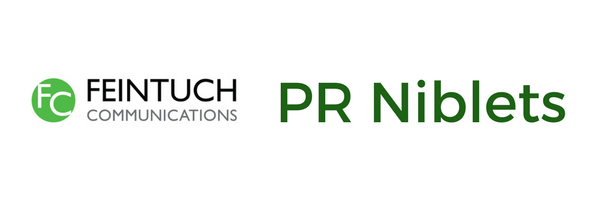By Henry Feintuch
Click here to listen to Henry’s appearance on Food for Thought: Lunchbreak with Steve Bookbinder.
 A few months ago, my
phone rang. On the other end was Steve Bookbinder, a
long-time business friend and CEO/lead trainer at DM Training, a professional
sales training and coaching business. Steve had recently started a podcast
series, Food
for Thought: Lunchbreak with Steve Bookbinder, as a vehicle to share his
expertise and attract prospective clients.
A few months ago, my
phone rang. On the other end was Steve Bookbinder, a
long-time business friend and CEO/lead trainer at DM Training, a professional
sales training and coaching business. Steve had recently started a podcast
series, Food
for Thought: Lunchbreak with Steve Bookbinder, as a vehicle to share his
expertise and attract prospective clients. Now, Steve is a salesman’s salesman. As a former actor, salesperson, entrepreneur, business owner and more, Steve has an uncanny ability to be able to sell any product, service or concept. And I mean that in the most flattering sense – he’s that good. Companies from around the world pay top dollar to fly Steve to meet with their sales teams to teach, motivate and expand their ability to grow and sell better in order to achieve their boldest sales objectives.
But back to the call. Steve was looking to broaden his
podcast’s content by bringing in external subject matter experts. He wanted to
know if PR had a direct impact on the sales process and – if so – could I join
him for an episode to provide practical and actionable information for his listeners?
I had no choice but to accept.
You see, his request hit me dead-on in my philosophical
viewpoint regarding strategic public relations. Nearly every time I meet with a
prospective client, after they express their want/desire/need for PR support, I
ask, “why are you here?”
Now that’s not a glib question. I’m an entrepreneur and
business owner, and my company’s income fluctuates based on the number and size
of the PR programs I sell. But, as an ethical PR practitioner who really cares
about his career and industry’s reputation, I always want to understand the motivation
behind the need for PR – not just the perceived need. After all, how can my
team design an actionable campaign to achieve each company’s business
objectives unless we comprehend each organization’s needs and business
challenges?
- Is the prospective client losing business (or not growing as much) as a competitor?
- Are there misperceptions about the company in the market?
- Is there a business challenge in building distribution?
- Are competitors quoted more frequently and prominently in the media?
- Is there a long-term M&A or IPO strategy in the works and can PR help familiarize the market with a company?
…. Or any one of a hundred different underlying business
reasons motivating the need for PR.
 PR is far more than
generating press releases and publicity; it’s about helping companies to build
their thought leadership, generate more sales leads, improve their reputation,
find more and better distribution channels, influence the thinking of their
target audiences and more.
PR is far more than
generating press releases and publicity; it’s about helping companies to build
their thought leadership, generate more sales leads, improve their reputation,
find more and better distribution channels, influence the thinking of their
target audiences and more.
So, I recorded that podcast episode with Steve. The
15-minute segment turned into 34 minutes of airtime. I suspect I could have
gone on all afternoon if Steve didn’t put an end to our “shop talk” segment. And
you can listen to the episode here
– perhaps during your lunch break.
Stop me sometime, whether you have 34 minutes or a couple of hours, to discuss strategic PR. It’s a critical part of this industry I love.






